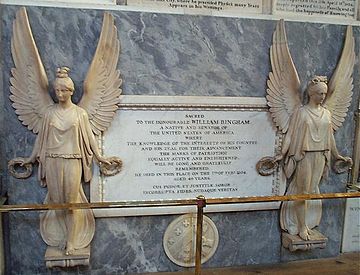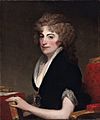William Bingham facts for kids
Quick facts for kids
William Bingham
|
|
|---|---|
 |
|
| President pro tempore of the United States Senate | |
| In office February 16, 1797 – July 6, 1797 |
|
| Preceded by | Samuel Livermore |
| Succeeded by | William Bradford |
| United States Senator from Pennsylvania |
|
| In office March 4, 1795 – March 3, 1801 |
|
| Preceded by | Robert Morris |
| Succeeded by | Peter Muhlenberg |
| 37th and 38th Speaker of the Pennsylvania House of Representatives | |
| In office December 4, 1791 – April 10, 1792 |
|
| Preceded by | Himself (as Speaker of the Assembly) |
| Succeeded by | Gerardus Wynkoop II |
| Member of the Pennsylvania House of Representatives | |
| In office 1793–1794 |
|
| Personal details | |
| Born | March 8, 1752 Philadelphia, Pennsylvania |
| Died | February 7, 1804 (aged 51) Bath, England |
| Resting place | New York City |
| Nationality | American |
| Political party | Federalist |
| Spouse | Ann Willing |
| Children | Maria Matilda Anne Louisa William |
| Alma mater | University of Pennsylvania |
| Profession | Banker |
William Bingham (March 8, 1752 – February 7, 1804) was an important American statesman and businessman from Philadelphia. He was a delegate for Pennsylvania in the Continental Congress from 1786 to 1788. Later, he served in the United States Senate from 1795 to 1801. He was known for being one of the wealthiest men in Pennsylvania during his time.
Contents
Early Life and Education
William Bingham was born on March 8, 1752, in Philadelphia. He went to college at the College of Philadelphia, which is now known as the University of Pennsylvania. He graduated from there in 1768.
Adventures and Business Beginnings
Bingham first traveled to Europe in 1773. When he returned to America, he joined the Philadelphia Society. During the American Revolution, he was sent on a secret mission to Martinique. His job was to pretend to be a merchant and set up communication with an American agent in France.
He sailed on a ship called Reprisal in July 1776. During his travels, he made connections with French merchants. He also helped capture several British ships. In 1777, he returned to America with many important supplies like guns and ammunition for the war.
Becoming a Wealthy Businessman
By the end of the American Revolution, William Bingham was one of the richest people in Pennsylvania. He earned his money by owning parts of privateer ships (private ships allowed to attack enemy ships) and through trading.
He became a big land developer. He bought large areas of land in upstate New York. He also bought 2 million acres (about 8,000 square kilometers) in Maine. This land later became known as the Bingham Purchase. He also helped arrange the Louisiana Purchase with important bankers from England. His daughter, Anne, even married one of these bankers.
Bingham was also the founder and first president of the Company of the Lancaster and Turnpike Road. This company built a major road from Philadelphia to Lancaster, Pennsylvania. He also owned shipping businesses and supported the growth of factories in America.
Leading a Cavalry Troop
In the 1780s, Bingham led a group of 50 cavalry soldiers called the Second Troop of Philadelphia Light Horse. These soldiers looked very fancy but did not see much fighting. In 1789, Bingham and his troop escorted George Washington through Pennsylvania. Washington was on his way to New York City to become the first President of the United States.
In 1787, Bingham was chosen to be a member of the American Philosophical Society. This group was for people interested in science and learning.
Political Career

William Bingham played an important role in the early government of the United States. He helped write the rules for the first national bank, called the Bank of North America. He believed that having a national debt could actually be good because it made more people interested in the government's success.
During the first presidency, Alexander Hamilton, who was in charge of the country's money, looked to Bingham for advice on managing taxes and setting up a national bank.
Serving Pennsylvania
From 1786 to 1788, Bingham represented Pennsylvania as a delegate to the Continental Congress. This was a very early form of the U.S. government.
In 1790 and 1791, he was elected to the Pennsylvania House of Representatives. He became its first Speaker in 1791. He also worked on developing roads and waterways in Pennsylvania. Later, he served in the Pennsylvania State Senate from 1793 to 1794.
United States Senator
In 1795, Bingham was elected to the United States Senate. He was a member of the Federalist Party, which supported a strong national government. When John Adams became President, Bingham served as the Senate's President pro tempore. This means he was the temporary leader of the Senate.
On March 4, 1797, he gave the oath of office to Thomas Jefferson, who became the Vice President. Some politicians who disagreed with him criticized him for his fancy lifestyle. However, he was very influential in early American politics. His home was a popular place for important politicians and leaders to meet.
Binghamton: A Lasting Legacy
William Bingham was also a land surveyor. He wanted to develop areas in southern New York and northern Pennsylvania. One of the best places he found was where the Chenango River and Susquehanna River meet.
To honor him, Judge Joshua Whitney Jr., a settler and Bingham's agent, named this town Binghamton. Today, Binghamton University also recognizes Bingham by naming Bingham Hall after him.
Family Life
William Bingham married Anne Willing. Her father, Thomas Willing, was the president of the First Bank of the United States. William and Anne had two daughters and one son.
- Ann Louisa Bingham (1782–1848) married Alexander Baring.
- Maria Matilda Bingham (1783–1849) also married into the Baring family.
- William Bingham (1800–1852) later moved to England.
Sadly, William Bingham's wife, Anne, died when their only son, William Jr., was very young. William Sr. left his son to be raised by his grandfather, Thomas Willing, in America.
William Bingham died on February 7, 1804, in Bath, England. He is buried in Bath Abbey. His family kept his large estate for many years after his death.
Portraits and Art
Bingham asked a famous artist named Gilbert Stuart to paint a full-length portrait of President George Washington. This painting, called the Lansdowne portrait, was given as a gift to Lord Lansdowne in England. Lord Lansdowne had helped bring a peaceful end to the American Revolutionary War. Gilbert Stuart also painted portraits of Bingham, his wife, and their children.
Images for kids
-
George Washington (Lansdowne Portrait) (1796) by Gilbert Stuart, National Portrait Gallery (United States).





